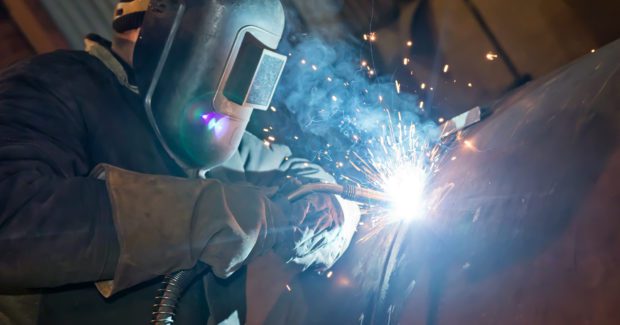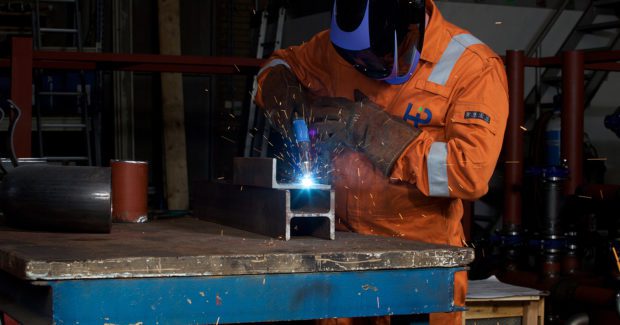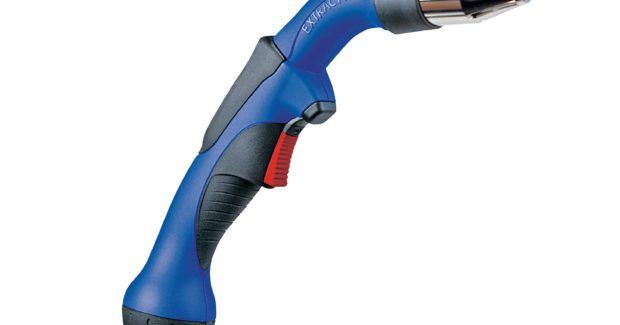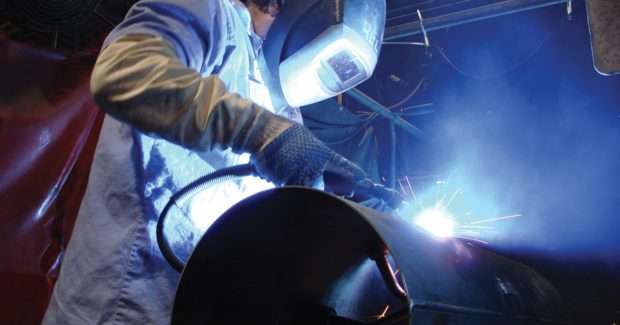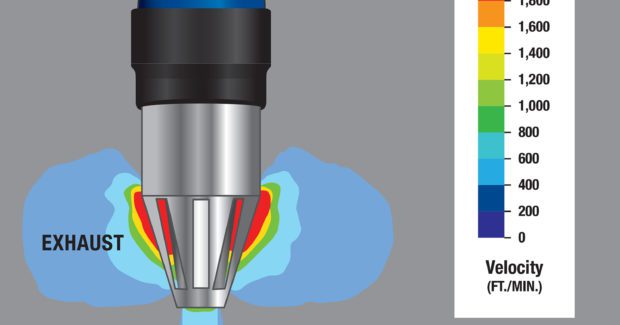Better Fume Control for Large Weldments Starts at the Source
Is your weld fume solution a fan and an open window? Working on large weldments – such as heavy equipment, ships or wind turbines – makes fume capture a challenge. However, today’s manufacturers have more options for fume control than ever. The best option for manual welding of large components may be one you haven’t considered for a while: the fume gun.
Posted: May 22, 2017
Large weldments present a couple of distinct challenges when it comes to weld fumes. Typically, these weldments are still done manually rather than by robots, which means the humans involved need protection from weld fumes. Large components, such as ship hulls or tractor trailers, cannot be contained under a hood for fume collection, or placed on a backdraft table or under a fume arm. Manual welders need to stay mobile to efficiently weld long seams, so they don’t want to be slowed down by fume collection equipment that needs to be moved or adjusted frequently.
WELD FUME MITIGATION OPTIONS FOR LARGE WELDMENTS
This leaves manufacturers that weld large components with just a few options for weld fume control:
- Ventilation is the traditional option, and is still commonly used in the industry. Manufacturers may use large fans to blow or pull smoke away from welders and towards ventilation systems that exhaust contaminated air to the outside. This may keep overall particulate levels in the facility within OSHA regulations, but does have several drawbacks. First, while welders move, the fans typically stay put; their effectiveness in keeping weld fumes away from the welder’s breathing zone can vary greatly depending on welder’s proximity to the fan. If the welder is in front of a fan that is pulling weld smoke in, the reduced pressure zone in front of the welder may actually pull more smoke into the breathing zone. At the same time, ventilation and exhaust systems can significantly increase heating and cooling costs, and may put facilities out of environmental compliance.
- Ambient filtration systems are more energy efficient and avoid the problem of exhausting contaminated air into the environment. Manufacturers can choose between traditional push-pull ducted systems or newer ductless push-pull systems like our Vista360. Both types of systems create air currents within the facility that continually pull contaminated air in and push clean, filtered air back out. These systems can provide effective whole-facility air quality control for manufacturers with parts that cannot be contained under hoods. However, they do not keep weld fumes out of the welder’s breathing zone, where it matters most. In a large facility engaged in high-volume manual welding, ambient systems also need to move a lot of air to keep particulate levels under control, requiring a high-cfm machine with higher operating costs.
- Powered air purifying respirators (PAPRs) protect welders from the effects of uncontrolled weld fumes. They are often used in conjunction with an ambient filtration or ventilation system. The main disadvantages in relying on PAPRs are comfort and cost. The systems are hot, bulky and uncomfortable, leading many welders to avoid using them even when they know they should. They also require frequent filter changes and upkeep to maintain their effectiveness and must be replaced periodically.
- Fume guns combine the weld torch with a tip extraction system that collects weld fumes right at the source. A good fume gun can collect 90 percent or more of weld fumes as they are generated, before they enter the welder’s breathing zone. They provide highly effective fume control for manual MIG welding. Fume guns are the ideal solution for many applications involving large weldments and high welder mobility. Unlike fume arms, which must be manually moved as the welder moves, the built-in extraction system in a fume gun is always positioned right where it needs to be to collect weld fumes.
NOT YOUR FATHER’S FUME GUN
If you haven’t used a fume gun lately, you may be in for a surprise. Previous generations of fume guns were heavy and bulky, impeding visibility of the weld seam and leading to welder fatigue if used for long periods of time. Many welders also reported problems with weld quality. Advances in extraction technology have eliminated these drawbacks. Today’s fume guns combine high-power extraction and excellent weld seam control in a package not much larger than a standard weld torch. For example, our Extractor™ weighs in at just 2.86 lb (1.3 kg) and reduces weld fume exposure by 90 percent to 95 percent. The small size and streamlined handle and nozzle ensure good visibility of the weld seam and reduced welder fatigue.
https://youtu.be/o9SV_wwScHw
Fume guns can be used for MIG and GMAW processes that employ shielding gas. They are not used for TIG or resistance welding. The fume gun looks and operates almost exactly like a regular weld torch. The only difference is that in addition to the hose carrying shielding gas to the torch head, there is a second hose for fume extraction inside the weld torch. This hose is hooked up to a high-vacuum dust collector. A specialized nozzle pulls weld fumes in as shielding gas goes out.
GETTING STARTED WITH FUME GUNS
There are a few things to know before selecting your fume gun system. First, make sure you are looking at fume guns with the latest technology. If the fume gun you are looking at is significantly heavier or bulkier than your standard weld torch, or inhibits weld seam visibility, welders may not want to use it. Like regular weld torches, fume guns come in both air-cooled and water-cooled models. The right choice depends on your application and the type and thickness of material you are welding:
- Air-cooled torches are more portable than water-cooled systems and less expensive to buy and operate. Air-cooled torches are available with ratings from 150 amps to 300 amps with continuous duty cycle. They are usually heavier than water-cooled torches with the same amperage rating. They are best for low-amperage applications with shorter duty cycles.
- Water-cooled torches have greater cooling efficiency, so they can be smaller and lighter for the same amperage. However, these systems are more expensive to buy and operate. Water-cooled systems are available with ratings from 300 amps to 600 amps with continuous duty cycle. They are best for high-amperage applications.
The second choice you will need to make is the kind of dust collector you want to hook your fume gun to. If individual welders do not require too much mobility, you can hook several fume guns up to a large, high-power central dust collector. This works best if each welder remains within a defined area at all times and all weldments are within reach of the fume gun hose (this generally means a radius of about 50 ft). For welders requiring more mobility, look for a lightweight portable unit like our ProCube™ that can be moved along with the welder. These units greatly expand the range for welders who need to complete very long weld seams or move around large pieces of equipment. Portable units can usually accommodate one or two welders with fume guns. If mobility is a priority, look for a wheeled unit that can be easily moved by one person.
When setting up your new system, make sure you know how to control both the shielding gas and the extraction power (cfm). These will need to be balanced; if extraction is set too high, it will suck in the shielding gas along with the weld fumes, resulting in poor weld seam quality. Portable dust collectors allow operators to adjust the motor speed to directly control cfm. Ducted dust collection systems can usually be controlled with a valve. The Extractor has a sensor system that tells operators when suction power is in the right range. This usually only has to be done the first time you set up the system. Once the system is set up, there is nothing for the welder to remember to do. As long as the dust collector is turned on, fume extraction happens automatically as welding takes place. In most cases, the welder will notice no difference in handling or use when switching from a regular weld torch to a modern, lightweight fume gun – except for dramatically cleaner air.
Fume guns may not be the only option for working with large weldments, but in many cases they are the best one. Nothing else removes weld fumes right at the source. They provide the best combination of safety and ease of use for welders working on large equipment.





